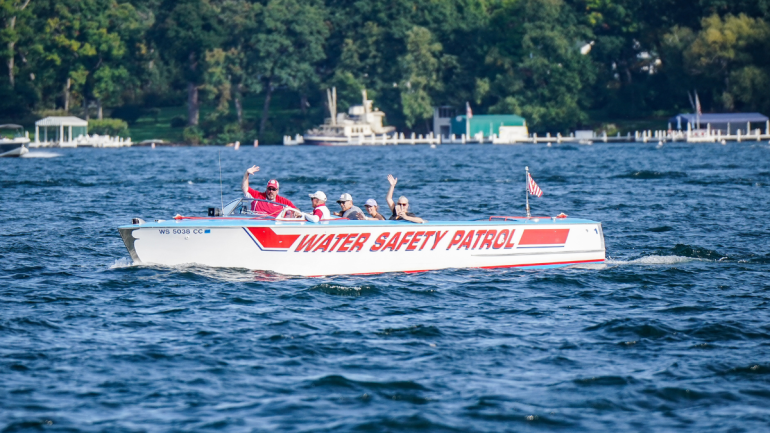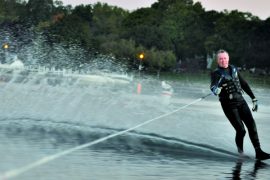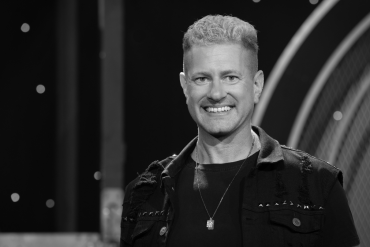By Amanda N. Wegner | Photo by Holly Leitner
For many Geneva Lake residents and regular visitors, Captain Sean “Slats” Slattery is a constant presence on the lake each season, helping keep boaters and water recreationists safe, and standing ready to respond to emergencies.
“Helping people on the water is something I love to do,” says Slattery. “Whether you call it a calling or a passion, I feel so lucky that I get to do it.”
Slattery has worked with the Geneva Lake Water Safety Patrol for 26 seasons, serving as an assistant director for 18 years, and now a senior staffer on the boat crew. The Water Safety Patrol is a private, nonprofit organization founded more than 100 years ago with a mission to keep Geneva Lake safe. The organization provides lifeguarding services and educational classes, including swimming lessons and boating safety courses. But the hallmark of the organization is its boat patrol, which is on duty from 9 a.m. to 9 p.m. every day during the summer, and on-call for emergencies 24 hours a day.
Slattery has spent more than two decades and countless hours patrolling the lake as a member of the Water Safety Patrol. His longstanding love of the lake and water safety is rooted in summers on “those magic waters” and being in the right place at the right time.
A SELF-PROCLAIMED “LAKE RAT”
Originally from the northwest side of Chicago, Slattery spent his summers at his family’s home in Glenwood Springs on the west end of the lake. “My dad’s family made the original connection in the ’50s,” says Slattery. “Grandpa was a mailman, and Grandma was a teacher; they had a dual income, which was a rarity, and they decided to buy a house up here. One of the joys of being here for so long is having relationships with other families you’ve known for generations.”
During Slattery’s summers at his grandparents’ house, he mostly spent his days on the water. “I was what you call a ‘lake rat,’” he explains. “We didn’t have cable, we didn’t have A/C, so we kids would wake up every morning and go down to the lake, playing ragtag and ‘king of the pier.’ I would spend every day on the water, and I fell in love with it, those magic waters.”
As a child, Slattery took swim lessons through the Water Safety Patrol. When looking for a job as a teen, he turned again to the Patrol, first working as a lifeguard at age 17. “I lifeguarded for one year, and after working my first boat crew shift for the Venetian Festival fireworks my rookie year, I knew the boat was where I wanted to be.”
The following year, Slattery primarily worked on the boat crew, and, summer after summer, he returned, even after completing a degree in communications with a major in radio broadcasting.
“It just kept gnawing at me,” says Slattery of his desire to work on the water after graduation. “When summertime came around, I thought, ‘Well, I guess I better scratch that itch.’ So, I chose a path on the water instead of on a microphone.” Today, Slattery works at Streblow Custom Boats and will serve his 26th year on the Patrol this summer.
RIGHT PLACE, RIGHT TIME
Aside from his love of the water — and an addiction to boats — it was a chance occurrence that helped Slattery realize the importance of water safety. He explains that at age 9, he was near two young brothers, about ages 3 and 5, standing on a pier. The children’s father walked away to look at someone’s boat, and while unattended, the older brother hit the younger one, knocking him into the water.
“No one was around, so I had to do something,” says Slattery, who pulled the younger brother from the water, saving his life. “I was in the right place at the right time.”
That experience sat with him, and the importance of staying safe around the water became ingrained in him.
“You never know when something is going to happen. The lake is my happy place, and no one thinks someone will almost drown in front of them. But if you’re not paying attention, not acting properly, it can happen.”
In addition to working on the Water Safety Patrol boat crew, Slattery teaches water and boat safety as a Wisconsin Department of Natural Resources (WDNR) boating safety instructor. “It is a real treat to be on the water and to teach the next generations of boaters and lake enthusiasts.”
Slattery is also trained as a first responder and has his EMT certification. He notes that these trainings allow him to be better educated and more prepared.
RISING TO THE CALL
According to the WDNR, Geneva Lake is the most heavily used body of water, per acre, in the state. In addition, the Geneva Lake Environmental Agency website estimates that between boats, paddleboards and other watercraft on buoys, lifts and piers, there were more than 5,000 watercraft on the lake last year, and that doesn’t even include day-trippers.
“We have every kind of boat and water toy imaginable, even the occasional seaplane,” says Slattery. “Given the variety and number of people out here, it [creates] the need to keep this lake safe, and it’s good our lake forefathers were smart enough to start this service.”
On weekdays in the summer, there are typically two Water Safety Patrol boats on Geneva Lake. There are additional Patrol boats dispatched on weekends and holidays, says Slattery, to provide better coverage, especially during what crew members call “the witching hour,” which is about 3 p.m. On the weekends, the lake tends to get more “active” around this time.
“The sunshine, the motion of the boat, what was had for lunch or not had for lunch, what has been consumed from one’s cooler, general shenanigans — you have to rise to the call and respond accordingly,” Slattery explains.
When not responding to emergencies or assisting with issues such as distressed watercraft or runaway boats, Water Safety Patrol boat crews are focused on interacting with and educating the public to ensure users’ safety on the lake. For lake users who “aren’t responsive” to the Patrol’s safety messages, “we’ll talk to our partners on the police boat to help remind them that their choices are financially not in their best interest,” Slattery explains.
In addition to working with the “police boat” (more accurately identified as the Geneva Lake Law Enforcement Agency or GLLEA), the Patrol also coordinates with WDNR wardens. “The DNR only has a few wardens per county,” says Slattery. “They are spread thin, and they view Lake Geneva in good hands between the GLLEA boats and ourselves. Not to toot our own horn, but Geneva Lake is fortunate to have us and the law enforcement boats on the water.”
At the end of the day, Water Safety Patrol is focused on ensuring users can have fun and be safe.“We want to make sure anyone who uses this water body, regardless of age, race, creed, color or bank account, goes home at the end of the day in one piece,” says Slattery. “It’s never fun when your day on the lake ends up at the hospital or somewhere else because of bad luck or bad decisions.”
A HUMBLING EXPERIENCE
Through his two-plus decades with the Water Safety Patrol, Slattery has experienced some memorable rescues but also tragic events. “You either remember the things that went really well or really bad,” says Slattery. “But there’s a lot of stuff in the middle.”
On the bad end, Slattery shared the story of his first fatality incident, when too many individuals packed on a 21- foot rental boat made questionable choices on the water, and the boat’s driver ran over one of the passengers in the water. “That happened on a fateful Monday in July and is one I will never forget,” recalls Slattery, adding the body wasn’t recovered until Thanksgiving of that year.
He also recalls his first rescue on the boat crew; a little girl fell while playing ragtag at her subdivision pier and cut open her shin on the diving board, exposing her shin bone. She “took it like a trooper,” says Slattery, and her mother took her to the hospital to get patched up. Several years later, while doing a lifeguard orientation meeting, two new guards came up to Slattery, reminding him of that incident.
“One came up and said, ‘You may not remember us from Sunset Hills, but you helped my girlfriend. We remembered that … it was really cool, and it made us want to work for Water Safety Patrol,’” says Slattery, noting they moved up to boat crew and became good crew members. “Getting to have moments like that is wonderful.”
There was also an incident where a young girl got whipped off her tube while tubing behind a boat. Her parents were nervous that she had whiplash, so they called the Patrol, who backboarded the girl and put her in a cervical collar. “At first glance, she had no apparent injury, but we learned later she hyperextended every ligament in her neck,” recalls Slattery.
About a week later, he was out on shift and received a call to swing by the pier to pick something up. As he pulled up to the pier, he saw the girl’s mother standing there with a tray of cookies. She wanted to meet the rescuers who helped her daughter and shared that her daughter could have been paralyzed without the boat crew’s help due to her injuries. “I’m tearing up now thinking about it,” says Slattery. “It’s a humbling and unique experience to be part of so many people’s stories. I’m very thankful to have the privilege to work for such a unique organization and to put my blood, sweat and tears into it.”
SEAN’S SAFETY TIPS
- CLIP BEFORE YOU DIP. Before you enter the water from your boat, put on a life jacket (PFD) , no matter how strong a swimmer you are.
- On Geneva Lake, anyone being towed on a tube, waterskis, wakeboard, surfboard, etc., is REQUIRED to wear a PFD.
- Make sure you have enough life jackets on board the boat for everyone, in the proper size and fit.
- If someone needs help in the water, DON’T jump in before putting a life jacket on yourself. Many people have drowned while trying to save someone else. Better yet, try to reach the person with something (a rope, paddle, waterski), or throw something to them (a PFD, seat cushion, rescue ring).
- Anchor your boat if you intend to swim from it. This will help to prevent it from drifting away. Always make sure that someone is left on board who can operate the boat if needed.
- Swimmers are REQUIRED to stay within 50 feet of the boat while in the water. Have a rope with a PFD attached to it tied to your boat while people are swimming so they can stay close.





